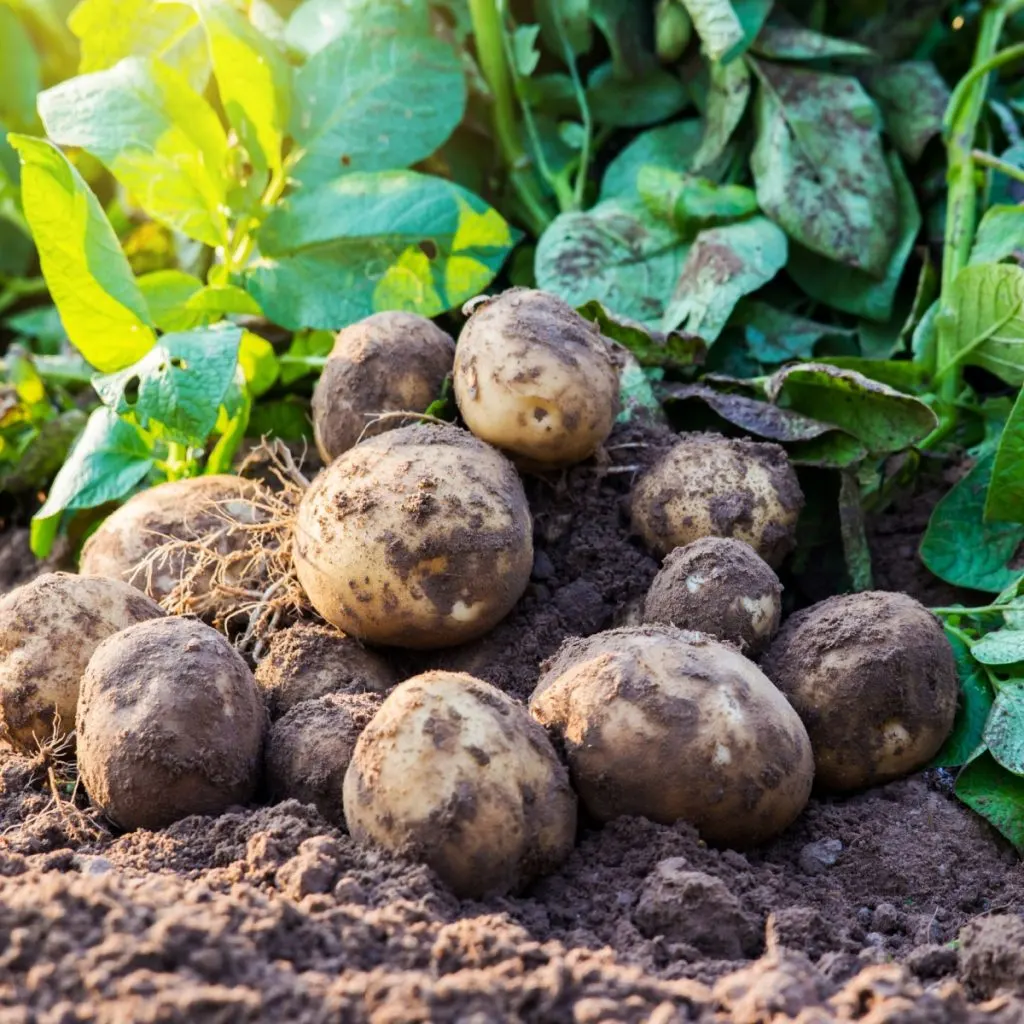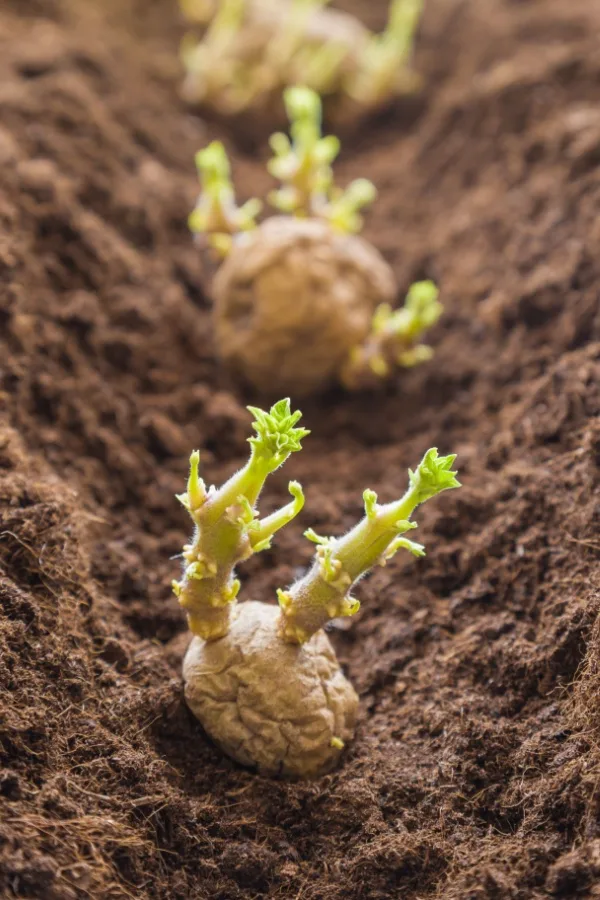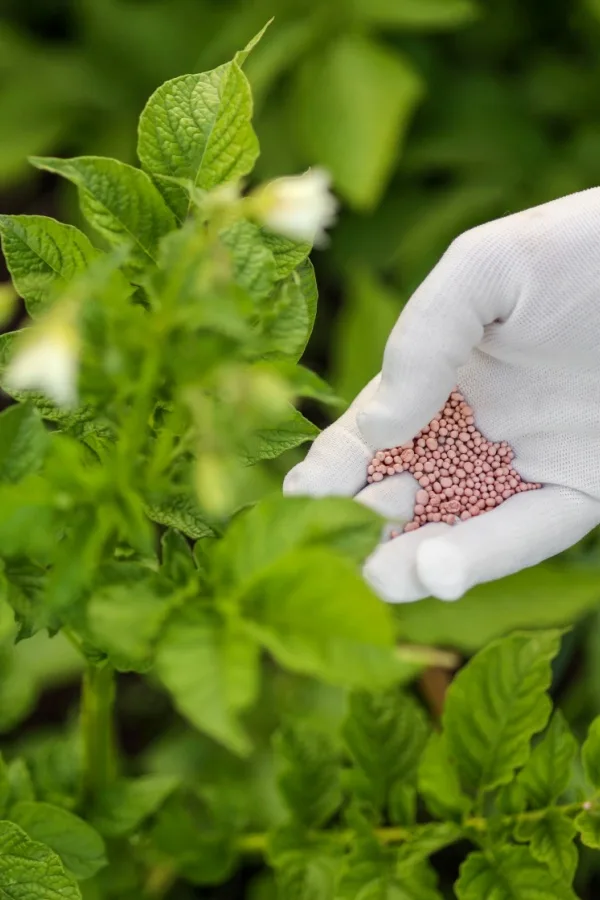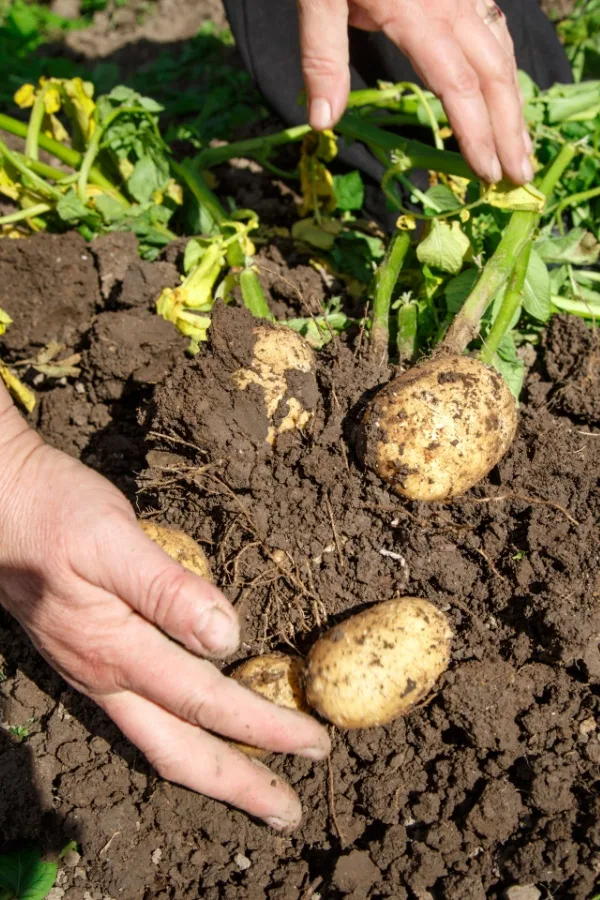One of the biggest secrets of all to grow a large, healthy potato crop with loads of foliage and plenty of potatoes to harvest is knowing when and how to properly fertilize them – and when to stop!
Potatoes are heavy feeders that require plenty of nutrients throughout the growing season. Failing to provide plants with additional nutrients can cause plants to struggle to push out a strong leaf set – let alone produce enough potatoes for a sizable harvest.
Fertilizing potatoes is a task that many gardeners often forget or fail to do. And even when they do provide plants with additional power, the timing and amount of fertilizer often don’t match what the plants require.

A lack of nutrients is especially an issue if you are growing potatoes in containers or raised beds. The limited amount of soil and lack of space often means plants deplete the available nutrients long before the growing season is over.
With the inability to see the “harvest” until digging the potatoes up, it’s simply difficult to know exactly how the plants are doing. But that is exactly where fertilizing can ensure success. And the good news? It’s easy to do!
How To Fertilize Potatoes
Before Planting
Before you even go to put a seed potato into the soil, you need to amend the soil with plenty of aged compost. Whether you plant potatoes in containers or in rows in the ground, a couple of inches of compost will help give them a great boost of nutrients right from the start.
These additional nutrients will allow the seed potatoes to easily sprout and start establishing root systems. In addition to adding nutrients, compost will also help to add organic matter to the soil. This creates looser soil that allows potatoes to expand and grow easily in.

You can also apply a slow-release fertilizer before planting as an alternative to the compost. While it won’t help the soil composition, it will still help provide seed potatoes with plenty of nutrients to sprout and start the growing process. Either way – it’s important to give your crop energy right from the start!
Powering Potatoes During The Season – How To Fertilize Potatoes!
The initial dose of compost or slow-release fertilizer will be enough to get plants through the first part of sprouting. In the meantime, keep plants well watered. Proper moisture early on is a big key to bigger potato growth. With that said – always avoid overwatering as standing water can rot potatoes out.
Once plants are about six inches tall, it’s time to start hilling plants and begin regular fertilizing. Hilling is the process of adding additional soil on top of growing plants. This helps to protect the growing tubers as well as encourages additional growth.
Mixing compost into the soil as you hill plants is a great way to provide additional nutrients as the plants grow. However, it’s also a good idea to start using granular or liquid fertilizers in addition to the compost.
What To Use To Fertilize Potatoes
Fertilizers all contain a specific mixture of nutrients. They are labeled with a different ratio of N-P-K amounts: N is for nitrogen, P is for phosphorus, and K is for potassium. Each of these nutrients performs a different job when it comes to powering potato plants.

Nitrogen is vital for good foliage growth and can help decrease the chance of early potato blight. While it is important for potatoes, too much can limit both yields and the quality of the tubers produced.
Phosphorus and potassium, on the other hand, are more important for improving strong root growth and healthy tubers. Since potatoes are a root crop, these two nutrients are much more vital for a successful potato crop and harvest.
Choosing A Fertilizer
When fertilizing potatoes, it’s important to select an all-purpose fertilizer that has a higher ratio of phosphorus and potassium. A ratio of 5-10-10 is an ideal choice for potato crops. Product link: 5-10-10 Tomato & Vegetable Fertilizer
The reduced nitrogen number allows plants to push out plenty of lush, green foliage without overpowering plants. The increased phosphorus and potassium rates encourage excellent growth under the soil.
Granular fertilizers are a great option to use with potato plants. The granules can be used to side-dress plants throughout the growing season. As for the rate, always refer to the directions on the package for the specific amount and frequency of application.

One key with granular fertilizer is to never allow the granules to come into contact with any plant foliage. This can burn tender plant tissues. When fertilizing, if possible, water your crop after to wash any fertilizer off plants.
Liquid fertilizers can be used as an alternative choice. You will likely need to apply them a bit more often than slow-release granules, typically once every two weeks. Again, select a liquid fertilizer with a larger dose of phosphorous and potassium compared to nitrogen.
When To Stop Fertilizing
Just as important as knowing when and what to fertilize with is knowing when to stop fertilizing potato plants. Giving nutrients too late in the season can cause premature rotting of the crop. For best results stop powering your plant about two to three weeks before you expect to harvest.
In addition, it’s also a good idea to stop watering your potatoes about two weeks before harvest. Potatoes are much easier to harvest when the soil is dry – and again, it will help prevent the crop from rotting in the soil late in the season.

Potatoes can actually be harvested at different times throughout the summer. If you are looking to harvest new or baby potatoes, harvest about two weeks after the foliage stops growing.
For mature potatoes, harvest after the foliage has completely died back. Mature potatoes have a much better storage life and can often be kept over an entire winter season to be enjoyed. See: How To Harvest, Cure And Store Potatoes For Long-Term Storage
Here’s to properly powering your potato plants with fertilizers and additional nutrients this year – and to your biggest potato harvest ever!
This Is My Garden
Follow Our Facebook Page For Great Gardening Tips And Advice! This Is My Garden Facebook Page
This Is My Garden is a garden website created by gardeners, for gardeners. Jim and Mary Competti have been writing gardening, DIY and recipe articles and books and speaking for over 15 years from their 46 acre Ohio farm. They publish three articles every week, 52 weeks a year. Sign up today to follow via email, or follow along!
